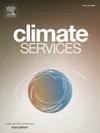城市洪涝风险分析,实施土地可持续利用措施
IF 4
3区 环境科学与生态学
Q2 ENVIRONMENTAL SCIENCES
引用次数: 0
摘要
在过去的几十年里,世界范围内洪水的强度和频率都在增加,导致了灾害发生率的显著增加。开展了城市土地利用空间分析,以解决洪水风险的根本问题,并制定长期措施。本研究提出了一种在社会-经济-结构-环境(S-E-S-E)框架内整合脆弱性和危害成分的洪水风险评估方法。脆弱性分为社会、经济和结构因素,而危害是根据地形和降水等环境变量确定的。城市洪涝风险分析结果表明,商业区和住宅区非常危险,而绿地对于分区来说是安全的。城市、西南和东南地区被发现是相对危险的地区。研究结果表明,城市人口密度高的地区、城市主要功能区、城市弱势群体和城市衰退地区的洪水风险较高。所提出的方法能够识别高风险地区,促进数据驱动的土地利用规划,实现可持续的城市弹性。该研究提供了一种系统的空间风险评估方法,可以适应面临类似气候挑战的不同城市环境,从而有助于制定城市洪水缓解策略。本文章由计算机程序翻译,如有差异,请以英文原文为准。
Analysis of urban flood risk for the implementation of sustainable land use measures
Over the past few decades, the intensity and frequency of flooding have increased worldwide, resulting in a significant increase in damage rate. Urban spatial analysis regarding land use has been conducted to address the fundamental problem of flood risk and prepare long-term measures. This study proposes a flood risk assessment approach that integrates vulnerability and hazard components within a Social-Economic-Structural-Environmental (S-E-S-E) framework. Vulnerability is classified into social, economic, and structural factors, while hazard is determined based on environmental variables such as topography and precipitation. The urban flood risk analysis results showed that commercial and residential areas are very dangerous, while green areas are safe for zoning districts. The urban, southwest, and southeast regions were found to be relatively dangerous for regions. These findings indicate that flood risk is high in urban areas with high population density, areas responsible for the key functions of the city, vulnerable groups, and declining urban areas. The proposed method enables the identification of high risk areas, facilitating data-driven land use planning for sustainable urban resilience. This study contributes to urban flood mitigation strategies by providing a systematic approach to spatial risk assessment, which can be adapted to different urban settings facing similar climate challenges.
求助全文
通过发布文献求助,成功后即可免费获取论文全文。
去求助
来源期刊

Climate Services
Multiple-
CiteScore
5.30
自引率
15.60%
发文量
62
期刊介绍:
The journal Climate Services publishes research with a focus on science-based and user-specific climate information underpinning climate services, ultimately to assist society to adapt to climate change. Climate Services brings science and practice closer together. The journal addresses both researchers in the field of climate service research, and stakeholders and practitioners interested in or already applying climate services. It serves as a means of communication, dialogue and exchange between researchers and stakeholders. Climate services pioneers novel research areas that directly refer to how climate information can be applied in methodologies and tools for adaptation to climate change. It publishes best practice examples, case studies as well as theories, methods and data analysis with a clear connection to climate services. The focus of the published work is often multi-disciplinary, case-specific, tailored to specific sectors and strongly application-oriented. To offer a suitable outlet for such studies, Climate Services journal introduced a new section in the research article type. The research article contains a classical scientific part as well as a section with easily understandable practical implications for policy makers and practitioners. The journal''s focus is on the use and usability of climate information for adaptation purposes underpinning climate services.
 求助内容:
求助内容: 应助结果提醒方式:
应助结果提醒方式:


